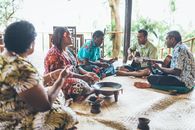The Ulumate Project: Na Tolu - Joana Monolagi, Ole Maiava & Daren Kamali
The Ulumate Project: Na Tolu is an exhibition showing at Objectspace until the 26th of Feb 2023 by Joana Monolagi, Ole Maiava & Daren Kamali.
Ulumate was traditionally observed during a time of mourning, when the drau-ni-ulu (hair) was cut and made into a wig, then worn until the hair beneath grew back. In pre-Christian Fiji, ulu cavu (hair wigs) were also worn in warfare. Post-colonisation, Qita (selected men) wore ulu cavu as they stood guard over the village plantation.
Together with photographs, masks and masi, this exhibition features the first ulu cavu made in more than 200 years, woven by Joana Monolagi with hair collected from Daren Kamali.

We talked to Daren who earlier this year won the Creative New Zealand, Pacific Heritage Arts Award about the exhibition below
-
What is an ulumate and what is its significance to Fiji culture?
Ulumate Project, or the term Ulu mate refers to the entirety of the human head, whereas ulu cavu is the generic Fijian-iTaukei term used for the human hair wig - held in various Aotearoa NZ, housed in international museum collections and displayed by Na Tolu.
The significance and commonality of this Ulumate Project is Bringing Back the Forgotten to today from a couple centuries ago, it is to express how important and sacred the human head is in Fijian culture and throughout Moana Oceania, our hair signifies Mana.
It is relatable internationally as most cultures won't just approach anyone and request a haircut or hair dressing or even personal space like touch. The head is the most sacred area of a Fijian person.


Why is it important for young generations of Pasifika to connect with these taonga from our history?
It is about connecting back to our roots/routes, whether it is a Ulu cavu wig or Tuiga of Human hair from Samoa; It teaches us respect and honour for those gone before and for ourselves and each other, especially for our Pacific men.
There's so much pride and Mana in our culture and it's important to tell our stories and express ourselves creatively or how we know and that's the reason behind this Revival, Research, Arts/Activation project.
We are also in a safe place and I'm grateful to be here in Aotearoa where this practice is possible and we have amazing support and lolomas around us.


Tell us about the making of it and the items in the exhibition, and how Joana was involved in the project as an artist?
Initially, I was looking for a Fijian artist to collaborate with and was working with Inise Eremasi in Fiji before Nei Joana Monolagi asked me after my 2nd hair cutting ceremony, she said, "just let me know, if you want me to make the ulu cavu wig for you?" so I left it with her for a year in 2020 and she made the wig out of Fijian materials like the magi magi - coconut sinnet, Vau - hibiscus fibre and cotton as well as the hair.
All the adornments in the images were made by Joana Monolagi - Bati ni Vuaka - Boar Task necklace, Wasekaseka - Breastplate, made from Clay and Masi.





What has been the highlight of working on this project for you and the team?
There have been quite a few actually.
One of the highlights was picking up the first made contemporary ulu cavu wig - made from my hair of 25 years on the 31st of March last year, such an uplifting-spiritual feeling; the opening of this current exhibition and lead up to it; another was our visit to the Cambridge Museum in London to see the Eight ulu cavu wigs in their collection, the research and learning into the background of this iyau and many others.
Working with Ole Maia and Joana Monolagi has been the greatest highlight.

Why was this kaupapa important to you on a personal level as a Fijian artist?
I try to find a way home to Fiji in all that I do creatively. This Ulumate Project by far has really delved me deeply back in to my roots and culture, also collaborating with Na Tolu has been an amazing journey thus far, since 2013 and I'm still learning so much about Fiji and the Saltwater Realm and of course Na drau ni ulu tabu: The sacredness of Human Hair.





